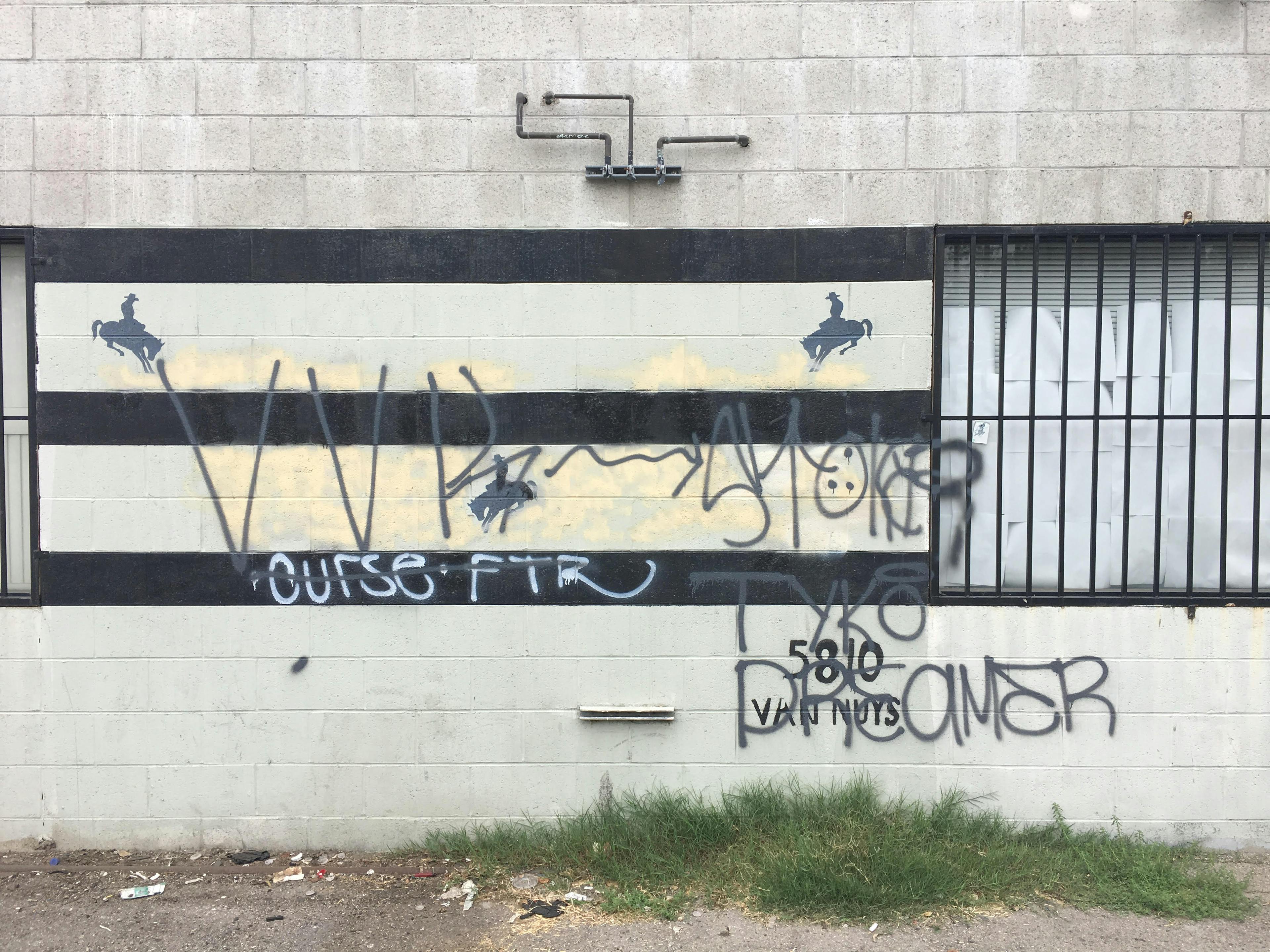Of the many stylistic inventions of the medieval European aristocracy, the lawn must rank among the most enduring. Like so many venerable trends of the wealthy and powerful, it was exported throughout the world, and as it migrated from the manors of England to the mansions of Beverly Hills the lawn was unassuming, leaving its footprint on modest suburban tracts and bland municipal landscapes in addition to the stately homes of the rich and powerful. In order to complete its migration to California, the lawn needed to diversify from the cool season grasses that dominate in temperate climates. Bermuda grass, with its tolerance for heat, drought and generally tough conditions was an early introduction for the California lawn. As the years have passed climate realties have begun to persuade Angelenos to kill their lawns, but Bermuda grass is here to stay. It migrated out of its neatly manicured LA home long ago, and now thrives un-mowed and un-fertilized in the streets of Los Angeles.
Bermuda grass is a low growing perennial species with leaf blades that are thin and short which can be hairy or smooth. It can propagate itself in several ways. Its underground rhizomes quickly establish new plants, and are difficult to fully eradicate by hand weeding. The growing tips of these rhizomes resemble the canines of man's best friend, which gives the plant its Latin name Cynodon, meaning dog-tooth. Above ground, it also propagates itself from stolons, creeping stems which can differentiate into roots and shoots. This contributes to a matted, thick quality which makes for a good lawn. Bermuda grass lawns are tough, durable and rather pleasant to walk on with bare feet. In addition to these clonal strategies of dispersal, Bermuda also produces seeds which establish new plants. Seeds are borne on inflorescences containing three to seven spikes which spread from a central point, looking quite similar to the seed heads of the dreaded Crab grass. Despite its common name, Bermuda grass did not originate in Bermuda. It's ubiquity as a weed and cultivated species in much of the world's warm climates have obscured its exact native origin, but most botanists believe that it originated in Africa. A number of other species occur in the same genus, all of which originated in tropical and subtropical regions of the old world.
Bermuda grass is well established in inner city LA. Being a lawn grass, it is sometimes encountered as a large clone, but also establishes itself as an interloper in lawns of a different species. In these cases, it can be spotted as a slightly different colored patch contrasting with the green shades of the other grass species. It is a true street plant, growing in the most heavily urbanized and paved over environments of the city including cracks in sidewalks, parking lots, and roads. Although it can form dense, lawn like patches in the streets, its typical habitat of cracked paving often prevents it from forming a thick mat, and instead it grows as spidery single plants, sprawling themselves above the pavement. Occasionally, it grows with the habit of a vine, climbing with its stolons through the corrugated interior of sign posts to flower and spread its seeds from above the street names.
This is among the few plants which occupy both ends of the horticultural zeitgeist. On the one hand, it is a tough, even growing lawn grass which doesn't need much attention to thrive. On the other, thanks to its deep roots, tough rhizomes and stolons it is one of the most tenacious and difficult to eradicate weeds. This gives horticultural capitalists the opportunity to extract money from this plant during both its birth and death. The same mega retailer which sells Bermuda grass seeds ("thicker, greener grass, guaranteed") also sells a product called Bermudagrass Control which is specially formulated to "remove undesirable bermudagrass weeds." This product is advertised primarily as a way to kill Bermuda grass in lawns, without damaging the other lawn species. Its active ingredient, fenoxaprop‐P‐ethyl works by inhibiting enzymes which in turn blocks the synthesis of fatty acids, eventually killing the plants. Warm season grasses such as Bermuda grass are more sensitive to this than their cool season counterparts, allowing a properly calibrated herbicide solution to be sprayed on lawns of cool season grasses to eliminate Bermuda grass without killing the lawn. Plants in the eudicot group, which includes many broad leaved plants are even more immune to this class of herbicide, and the ability to selectively kill non desirable plants in a plot of grass is big business. Chemistry, commerce and bio pathways aside, it's impressive how sophisticated our pursuit of the perfect lawn has become.
Precisely when lawns fully detached from their precursor of pastoral, livestock supporting landscapes is hard to pinpoint, but at a certain time, human recreation and leisure rather than the production of food became the dominating factor. A perfectly manicured yard is not only a great place to play and lounge around, but also a symbol of the copious free time or money that the owner can afford to put into maintaining it. And what conjures the American dream more than a bright green front yard? Of course some regions of the US are more suited to the lawn than others. Left to its own devices, the California landscape (with hills now dominated by European annual grasses), greens up spectacularly for a short wet window during the winter before the heat and drought of summer set in, turning verdant hills to yellow brown. And a brown lawn is a bad lawn, so California lawns can't be left to their own devices.
In the mid nineteenth century, an editorial in the California Farmer waxes poetic about the English lawn:
"Few who have not seen or trod the 'velvet turf' of England can fully realize its surpassing beauty...We shall not deny that the peculiar climate of that kingdom, tempered as it is by its surrounding sea, with an atmosphere ever moist and humid, is particularly favorable to the perfection of the English lawns; but that we cannot very nearly imitate them, with the same care and attention which have chiefly contributed to make them what they are there, we also deny."
The article goes on to describe an incredibly laborious process of plowing, amending, perfectly timed seeding, and the correct mowing pattern to grow a respectable lawn in California. Though it's hard to imagine any of the hard scrabble pioneers of 1850s California following the editorials advice and investing their time in such a frivolous endeavor, the lawn was successful in its migration from the UK to California and is deeply entrenched today. What that article omits almost entirely is the key ingredient in the production of a good California lawn: water. In the case of Los Angeles, the tapping of rivers and draining of lakes coupled with a delivery system which could pump water over mountains and through channels dug across hundreds of miles of desert was all it took for the lawn to become a fixture in every suburban home in the South Land. The climate of LA was better suited to warm season grasses than the typical fescues and bluegrasses of the north, and Bermuda grass, with its tolerance to drought, heat and a wide range of soil conditions was a perfect fit.
Just a few years after that celebratory article was written, William C. Walker, a San Francisco nurseryman who introduced many exotic plants in the early days of California horticulture, listed flats of Bermuda grass in his extensive catalogue. The cost of five dollars per flat in 1858 was roughly equivalent to $150 dollars today, a high price for a plant that would go on to become a common weed. At that time, it was already naturalized in the Southeast US (and likely had been for 100 years or more), but it's unclear exactly when Bermuda grass went feral in California, and whether Walkers nursery was the original source of plants. The earliest scientific record of Bermuda grass in California dates to a specimen collected in 1875 in Santa Cruz. Fifteen years later, the first specimen from Los Angeles was collected in East LA by Anstruther Davidson, though it was likely established in LA well before then. A Los Angeles Herald article published in 1878 lamented that though it was probably the best lawn grass for the LA climate, it was nearly impossible to control it from escaping the neat confines of the lawn. This article is an early glimpse into the double edged nature of this plant. Articles advocating the conversion of alkali soils of the Long Beach area into "fruitful pear orchards and meadows of luxuriant Bermuda grass" are published alongside others which describe the resentment of homeowners towards Bermuda grass for invading their bluegrass lawns (apparently in the early 1900s a rumor was circulating that seeds were being spread through water provided by Los Angeles Domestic Works.) For better or worse, Bermuda grass still inhabits that liminal space today.
If Bermuda grass exists in a nebulous dual state of wonderful and terrible, the same can surely be said for the California lawn. The provider of countless birthday parties, games of catch, rolling around with the family dog, and many other memories is an awkward target for an environmental community which justifiably questions the validity of growing lawns in a water starved part of the world. That is a much larger story, of which Bermuda grass plays a role. But whether the Los Angeles lawn remains a part of life in the city or falls out of fashion in favor of a more sustainable model will not affect the survival of Bermuda grass in LA. Its escape from the lawn is complete, and it will thrive in the untended city streets for years to come.

